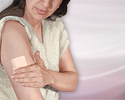Nicotine replacement therapy
Smoking cessation - nicotine replacement; Tobacco - nicotine replacement therapyNicotine replacement therapy is a treatment to help people stop smoking. It uses products that supply low doses of nicotine. These products do not contain the other toxins found in smoke. The goal of therapy is to cut down on cravings for nicotine and ease the symptoms of nicotine withdrawal.
-
Information
Before you start using a nicotine replacement product, here are some things to know:
- The more cigarettes you smoke, the higher the dose you may need to start.
- Adding a counseling program will increase your chances of quitting.
- DO NOT smoke while using nicotine replacement. It can cause nicotine to build up to toxic levels.
- Nicotine replacement helps prevent weight gain while you are using it. You may still gain weight when you stop all nicotine use.
- The dose of nicotine should be slowly decreased.
TYPES OF NICOTINE REPLACEMENT THERAPY
Nicotine supplements come in many forms:
- Gum
- Inhalers
- Lozenges
- Nasal spray
- Skin patch
All of these work well if they are used correctly. People are more likely to use the gum and patches correctly than other forms.
Nicotine patch
You can buy nicotine patches without a prescription. Or, you can have your health care provider prescribe the patch for you.
All nicotine patches are placed and used in similar ways:
- A single patch is worn each day. It is replaced after 24 hours.
- Place the patch on different areas above the waist and below the neck each day.
- Put the patch on a hairless spot of your body.
- People who wear the patches for 24 hours will have fewer withdrawal symptoms.
- If wearing the patch at night causes odd dreams, try sleeping without the patch.
- People who smoke fewer than 10 cigarettes per day or who weigh less than 99 pounds (45 kilograms) should start with a lower dose patch (for example, 14 mg).
Nicotine gum or lozenge
You can buy nicotine gum or lozenges without a prescription. Some people prefer lozenges to the patch because they can control the nicotine dose.
Tips for using the gum:
- Follow the instructions that comes with the package.
- If you are just starting to quit, chew 1 to 2 pieces each hour. DO NOT chew more than 20 pieces a day.
- Chew the gum slowly until it develops a peppery taste. Then, keep it between the gum and cheek and store it there. This lets the nicotine be absorbed.
- Wait at least 15 minutes after drinking coffee, tea, soft drinks, and acidic beverages before chewing a piece of gum.
- People who smoke 25 or more cigarettes per day have better results with the 4 mg dose than with the 2 mg dose.
- The goal is to stop using the gum by 12 weeks. Talk with your provider before using the gum for a longer period.
Nicotine inhaler
The nicotine inhaler looks like a plastic cigarette holder. It requires a prescription in the United States.
- Insert nicotine cartridges into the inhaler and "puff" for about 20 minutes. Do this up to 16 times a day.
- The inhaler is quick-acting. It takes about the same time as the gum to act. It is faster than the 2 to 4 hours it takes for the patch to work.
- The inhaler satisfies oral urges.
- Most of the nicotine vapor does not go into the airways of the lung. Some people have mouth or throat irritation and cough with the inhaler.
It can help to use the inhaler and patch together when quitting.
Nicotine nasal spray
The nasal spray needs to be prescribed by a provider.
The spray gives a quick dose of nicotine to satisfy a craving you are unable to ignore. Levels of nicotine peak within 5 to 10 minutes after using the spray.
- Follow your provider's instructions about how to use the spray. When you're starting to quit, you may be told to spray 1 to 2 times in each nostril, every hour. You should not spray more than 80 times in 1 day.
- The spray should not be used for longer than 6 months.
- The spray can irritate the nose, eyes, and throat. These side effects often go away in a few days.
SIDE EFFECTS AND RISKS
All nicotine products may cause side effects. Symptoms are more likely when you use very high doses. Reducing the dose can prevent these symptoms. Side effects include:
- Headaches
- Nausea and other digestive problems
- Problems getting to sleep in the first few days, most often with the patch. This problem usually passes.
SPECIAL CONCERNS
Nicotine patches are OK for use by most people with stable heart or blood circulation problems. But, the unhealthy cholesterol levels (lower HDL level) caused by smoking do not get better until the nicotine patch is stopped.
Nicotine replacement may not be completely safe in pregnant women. The unborn children of women who use the patch may have a faster heart rate.
Keep all nicotine products away from children. Nicotine is a poison for children.
- The concern is greater for small children.
- Call the provider or a poison control center right away if a child has been exposed to a nicotine replacement product, even for a short time.
References
George TP. Nicotine and tobacco. In: Goldman L, Schafer AI, eds. Goldman-Cecil Medicine. 26th ed. Philadelphia, PA: Elsevier; 2020:chap 29.
Smokefree.gov website. Quit smoking. smokefree.gov/quit-smoking. Accessed March 23, 2023.
US Preventive Services Task Force website. Interventions for tobacco smoking cessation in adults, including pregnant persons: US Preventive Services Task Force recommendation statement. www.uspreventiveservicestaskforce.org/uspstf/recommendation/tobacco-use-in-adults-and-pregnant-women-counseling-and-interventions. Updated January 19, 2021. Accessed March 23, 2023.
US Food and Drug Administration website. Want to quit smoking? FDA-approved products can help. www.fda.gov/consumers/consumer-updates/want-quit-smoking-fda-approved-and-fda-cleared-cessation-products-can-help. Updated July 21, 2022. Accessed March 23, 2023.





